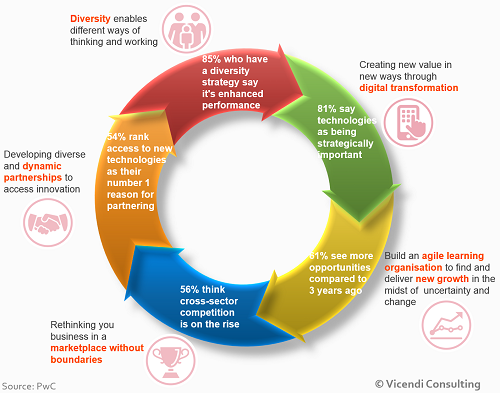5 Imperatives for competing in a marketplace without-boundaries

The foundation of strategy hasn’t changed; there are still only two ways to compete. Wherever we decide we will play, we have two choices of how to win: “Cost-Leadership” or “Differentiation”.
The problem is that competitive advantage is transient, short-lived. Because change is accelerating, the rate of innovation is ever increasing, and competition is intensifying and blurring boundaries. All this is supported by dynamic global capital and talent markets and a better access to information.
John Chambers’ recent HBR article Cisco’s CEO on Staying Ahead of Technology Shifts, starts with “Our success at Cisco has been defined by how we anticipate, capture, and lead through market transitions.” We learn that listening to customers provides key indicators when to make the jump. Cisco maintained the start-up mentality by moving out groups of employees to develop innovative products and “spin-in” them back into the company. And putting customer outcomes at the center of everything they do help companies stay ahead of the innovation wave.
So for businesses to enjoy a prolonged success in the marketplace, they need to focus on:
1 – Identifying shifts in markets and industries by listening to customers and developing a strong and diverse network of relationships.
2 – Making innovation a core activity, to create a pipeline of new advantages, through both launching internal start-ups and partnering with or acquiring promising disruptive enterprises.
3 – Making fast and roughly right decisions, moving fast to experiment, and then refine strategy and offerings. The Lean Startup methodology can provide the necessary tools for companies to quickly learn if their innovations are on path to a sustainable commercial success. For example, GE has been working with Ries to develop FastWorks, a program designed to deliver better outcomes for customers faster.
4- Bold management of the portfolio of advantages that can be built quickly and abandoned just as rapidly, in a way that focuses capital and people on the most value-creating activities.
5- Leading with a light footprint strategy while preparing for major long-term shifts. Look beyond existing models and current ways of thinking. Work with visionary experts from all works of life to develop few plausible scenarios of the economy and the society of the future. Constantly monitor and interpret the environment. Use leading indicators to shift focus and resources based on which particular scenario is unfolding.
In business, as in any other area of life, there is always risk of not wining every single bet. But nothing of value can be achieved without taking risk, as Mark Zukenberg’s said in one of his quotes: “The biggest risk is not taking any risk…in a world that is changing really quickly, the only strategy that is guaranteed to fail, is not taking risk.”
The stakes can be greater for those who pursue bold strategies to change the world. But it is possible to increase significantly the odds of success and reduce the cost of failures on the ways to accomplishing the vision, by: 1) seeking a diversity of opinions, 2) having the right people on the bus, 3) having the right financial bakers and mentors, and 4) joining efforts with the right partners in your ecosystems.



